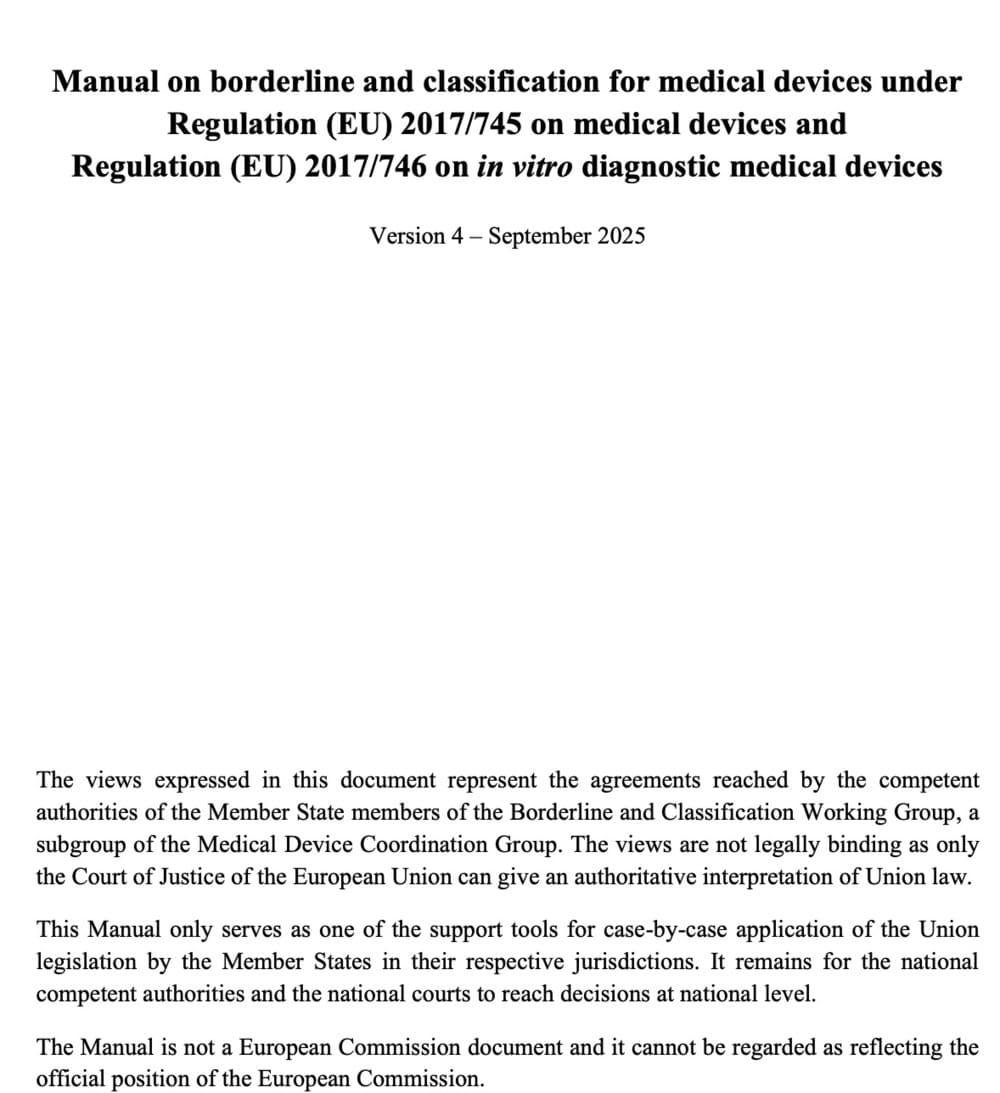
Version 4 of the EU Borderline & Classification Manual: What Manufacturers Need to Know (September 2025)
Medical devices regulation
On 12 September 2025, the European Union published version 4 of the Manual on borderline and classification, a reference document for the application of MDR (2017/745) and IVDR (2017/746).
This guide, regularly updated by the EU’s Borderline & Classification Working Group (BCWG), compiles real-world cases discussed as part of the Helsinki Procedure. It is a valuable tool for competent authorities, notified bodies… and of course, for manufacturers.
Here’s what you need to know about this new version.
The Role of This Guide in MDR and IVDR Context
The Borderline & Classification guide has a particular status:
- It is not legally binding, but reflects the consensus of European competent authorities;
- It serves to harmonize the interpretation of qualification criteria (is it a medical device?) and classification rules (which risk class?).
It is based on the Helsinki Procedure, a process of discussion between authorities to resolve ambiguous cases. The conclusions reflect a European consensus, even though they are not law.
What’s New in Version 4 (September 2025)?
Compared to version 3 (October 2022), this updated edition:
- Introduces several new cases, including 6 explicitly marked as new;
- Offers more detailed analysis of certain previously covered products;
- Covers new types of borderline products, including:
- Substances for local or systemic use
- Mobile apps and software
- Intelligent or interoperable accessories
- Combined products involving medicines or biocides
A significant update that confirms increasing regulatory expectations for product qualification and classification.
Practical Cases to Watch Closely
❌ Nasal spray with anti-COVID antibodies
This spray, derived from bovine colostrum, aims to neutralize SARS-CoV-2 in the nasal cavity.
Not qualified as a medical device: its mode of action is immunological → classified as a medicinal product.
✅ Root canal irrigation solutions (NaOCl and CHX)
Used in endodontics to clean root canals.
Accepted as class III MD if the manufacturer demonstrates a primarily mechanical mode of action, with antimicrobial effect as ancillary.
❌ Dual-action cream (menthol + capsaicin)
Analgesic cream claiming hot/cold effect to relieve joint and muscle pain.
Rejected as MD: both ingredients have documented pharmacological actions. The manufacturer failed to prove otherwise.
✅ Medical examination table covers
Disposable covers used to prevent transmission of infectious agents.
Qualified as class I MD: the intended purpose is disease prevention, which falls within the MDR definition of a medical device.
✅ Medical calculators
E.g. CHA₂DS₂-VASc score or creatinine clearance calculation.
Considered at least class IIa MDs, since they influence diagnostic or therapeutic decision-making.
✅ FeNO analyzer (exhaled air)
Device measuring exhaled nitric oxide for asthma-related inflammation.
Qualified as IVD: analyzes a biological specimen (exhaled air) and provides physiological data.
Key Takeaways for Manufacturers
This new vesion confirms a clear trend: qualification and classification decisions must be based on robust scientific evidence, not on marketing language or analogies.
What to keep in mind:
- A borderline product is not automatically a medical device: the burden of proof lies with the manufacturer.
- Omitting therapeutic claims is no longer enough: regulators assess the actual mode of action.
- Competent authorities and notified bodies use this manual to refuse market access or requalify products.
- Even legacy or previously approved devices can be challenged if the MDR requirements are not properly justified.
Mini FAQ
Is this guide legally binding?
No, but it reflects the consensus of EU authorities and is consistently used by notified bodies and courts.
Can I use it to support my product’s qualification?
Yes — and you should. But each case is assessed individually and must be scientifically substantiated.
If my product is similar to a listed case, is it automatically a medical device?
No. You must prove your product meets all relevant criteria — especially the intended medical purpose and mode of action.
Does this version affect IVDs as well?
Yes. A dedicated section addresses borderline issues under the IVDR.
What if my product isn’t covered in the manual?
That doesn’t mean it’s exempt — a full qualification and classification analysis is still required.
Need Help with Borderline Products?
At CSDmed, we support manufacturers with:
- Regulatory qualification of borderline products
- Risk classification (MDR/IVDR rules)
- Technical documentation, including for software and combination products
Contact us for a focused review or full analysis.
Better to anticipate than to face requalification.
Related Resources
- MDCG 2019-11: Qualification of Software
- MDCG 2022-5: Medical Device vs Medicinal Product
- Understanding MDR Annex VIII Classification Rules